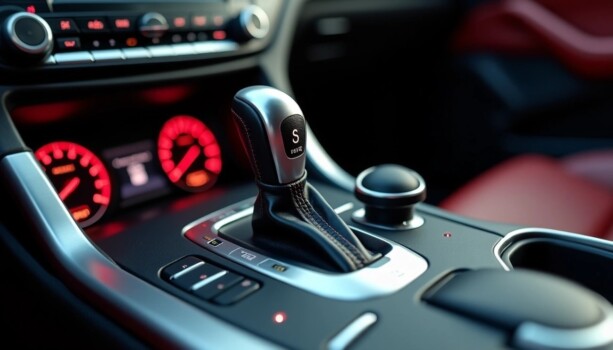Sport Mode optimizes your car’s engine control unit to enhance throttle response and gear shifting patterns. Your car holds lower gears longer and reaches higher RPMs before shifting up. This delivers quick acceleration whenever you need it. The performance boost requires more fuel because your engine runs at higher RPMs consistently. Sport Mode works best on highways and open roads where you need to overtake quickly. It’s not ideal for city traffic or slippery road conditions. Many car models also benefit from tighter steering and better torque in Sport Mode. These features give you improved handling during dynamic driving.
What is the S Gear in Automatic Cars?

The S gear in automatic cars represents Sport mode, a specialized transmission setting that improves your vehicle’s performance. Your car’s standard Drive setting focuses on comfort and fuel efficiency, while Sport mode rearranges transmission behavior to create a more engaging driving experience.
S Gear vs Drive Mode: Key Differences
Your automatic transmission works in normal Drive (D) mode to optimize everyday driving. It selects gears based on speed, load conditions, and efficiency. The main goal focuses on smooth operation and fuel conservation.
Sport (S) mode reshapes the scene of your driving dynamics in several ways:
Holds gears longer before upshifting, allowing the engine to reach higher RPMs Provides quicker downshifts when you need immediate power
Makes throttle response more immediate
Creates firmer, more aggressive gear shifts
May give better braking control on varying road gradients
Drive mode shifts at torque peaks during regular driving to maximize fuel economy through lower engine speeds. Sport mode shifts happen at higher points in the rev range where horsepower peaks. This core difference explains why your car feels more responsive in S gear.
How S Gear Alters Throttle and RPM Behavior
Your vehicle’s throttle and RPM behavior changes dramatically in Sport mode. The throttle becomes more sensitive and responds aggressively to even slight pedal inputs. This creates instant acceleration that feels completely different from Drive mode’s gradual response.
Your engine’s RPM behavior also changes significantly. Sport mode makes your engine:
- Keep higher RPMs in all driving conditions
- Wait longer before upshifting to stay in its power band
- Downshift faster when rapid acceleration is needed
The technical side shows that S mode tells your vehicle’s Electronic Control Unit (ECU) to focus on performance instead of economy. Your transmission locks to lower gear settings and keeps the engine running at higher revolutions. This setup means power is always ready, which helps with highway merges, passing other cars, or climbing steep hills where you need instant torque and power.
These performance improvements come with a trade-off – your fuel consumption increases because the engine runs at higher RPMs consistently.
How Sport Mode Works in Automatic Transmissions
Sport mode transforms your car’s behavior through complex mechanical and electronic adjustments. Your car switches from economy to performance the moment you activate this mode. The changes affect multiple vehicle systems.
ECU Behavior in S Mode
The Electronic Control Unit (ECU) works as the brain that makes Sport mode perform better. The ECU changes several key settings right after activation. The throttle becomes more sensitive, which gives you instant power every time you press the pedal. Your drive-by-wire system opens the throttle valve wider and lets more air into the combustion chamber. The computer also tweaks fuel timing to match this extra airflow, so your engine responds faster.
Gear Holding and Downshifting Logic
The transmission behaves completely differently in S gear. The system keeps each gear longer instead of trying to be efficient. Your car shifts at much higher RPMs to keep the engine ready for maximum power. You’ll notice more aggressive downshifting too. The transmission drops gears faster at higher speeds than in Drive mode to give you instant power. The shifts between gears happen faster and feel more crisp, making you feel more connected to your car.
Impact on Suspension and Steering (in Some Models)
Many cars extend Sport mode’s effects to how the chassis behaves. Models with the right equipment stiffen their suspension almost instantly when S mode kicks in. Cadillac Product Manager Harry K. Ng points out that advanced systems like Magnetic Ride Control can “change damping response in just 10 milliseconds” – faster than you can blink your eyes. Your car feels more planted during spirited driving. The steering becomes heavier and more direct, which helps you feel more connected. Advanced vehicles might even lower themselves using air suspension to improve stability. This reduces the center of gravity and spreads weight better across all four tires.
When to Use S Gear in Automatic Car

The right timing to use S gear in automatic cars can make a huge difference. Your driving experience and car’s health depend on it. S mode has specific uses that can boost handling and performance when you need it most.
Ideal Conditions: Highways and Overtaking
Highways and open roads give you the best chance to use Sport mode. S gear works best on long, clear stretches of road where you need quick power bursts. Sport mode is a great way to get better control during overtaking. A light touch on the pedal in S gear gives you instant acceleration that makes passing slower vehicles safer and quicker.
Sport mode works great on mountainous roads too. S gear stops the constant gear shifts that happen in Drive mode when you climb steep hills. This helps by:
Giving more power on uphill climbs
Cutting down transmission wear from frequent gear changes
Offering better engine braking downhill, which saves your brake pads
Avoiding S Mode in City Traffic and Slippery Roads
In stark comparison to this, city driving needs careful handling of Sport mode. The quick throttle response can make your car jerky in traffic. This discomforts passengers and wastes fuel.
S gear becomes risky on dangerous road surfaces. Snow or ice combined with extra power and sharp throttle response can make your car lose grip. Your car might have special snow/ice modes – employ those instead when weather turns bad.
Switching Between D and S While Driving
Modern automatic transmissions let you switch drive modes smoothly. You can move between D and S while driving without hurting your transmission. Notwithstanding that, these tips help get the best results:
Keep your speed steady when changing modes. Don’t switch while accelerating hard or turning. Stay light on the gas pedal during the switch.
This ability to switch between modes lets you adapt to different road conditions throughout your drive.
Pros and Cons of Using S Gear
S gear in automatic car transmissions offers several performance benefits but also brings some drawbacks. Drivers need to balance these tradeoffs based on their specific needs and driving conditions.
Improved Acceleration and Throttle Response
Your car becomes much more responsive in S gear. The throttle reacts quickly – push the gas pedal and power kicks in right away. This happens because the transmission behaves differently and:
Makes acceleration snappy and dynamic
Needs less pedal pressure to deliver power
Gives better control through corners on twisty roads Lets you pass other cars with more confidence
Real-world tests show big changes in how the engine behaves. At steady speeds, Sport mode pushes engine RPM up by 52-61% compared to normal mode. A car cruising at 60 mph on flat roads sees RPMs jump from 1700 in normal mode to 2600 in Sport mode.
Fuel Consumption and Engine Strain
These performance gains don’t come free. Your fuel economy takes a hit in S gear because the engine runs at higher RPMs. The engine parts also face more stress from spinning faster for longer periods.
Running in S mode puts extra wear on many parts – transmission components, engine bearings, and suspension parts wear faster. Mechanics often say, “The harder you drive a car, the faster its parts wear out”.
Does S Mode Increase Horsepower?
Your car’s maximum horsepower stays the same in S mode. The engine produces identical peak power no matter which transmission mode you pick. The difference lies in how quickly you can tap into that power.
Sport mode creates an illusion of more power through smart timing and throttle adjustments. The engine responds faster when you press the pedal, which makes the existing power easier to use in daily driving.
Conclusion
In this piece, we’ve looked at how S gear transforms your automatic driving experience. Sport mode offers substantial benefits when conditions are right. You get faster acceleration, better throttle response, and optimized gear patterns that make highway passing and mountain driving more fun.
But these performance gains come with trade-offs. Your fuel consumption goes up when you drive in S gear because of higher RPMs. The quickest way to handle this is to use Sport mode selectively – turn it on for open roads and challenging terrain, then switch back to Drive for city trips and bad weather.
On top of that, Sport mode doesn’t boost your vehicle’s horsepower. It changes how your existing power becomes available. Your transmission keeps lower gears longer and reaches those power bands faster when you need them.
The ability to switch between D and S while driving gives you great control over your car’s behavior. You’ll end up getting the most from your driving experience without putting extra strain on your engine or burning unnecessary fuel by knowing when and how to use S gear. Next time you spot that “S” on your gear selector, you’ll know exactly what it does and when you should use it.
FAQs
Q1. What exactly does Sport mode do in an automatic car?
Sport mode alters the car’s performance by adjusting throttle response, transmission shift points, and in some models, suspension and steering. It typically holds gears longer, shifts at higher RPMs, and provides quicker acceleration, creating a more dynamic driving experience.
Q2. When is the best time to use Sport mode?
Sport mode is ideal for highway driving, overtaking, and navigating hilly terrain. It’s particularly useful when you need quick bursts of power or enhanced control. However, it’s less suitable for city traffic or slippery road conditions.
Q3. Does using Sport mode affect fuel consumption?
Yes, using Sport mode generally increases fuel consumption. This is because the engine operates at higher RPMs, which requires more fuel. If you’re concerned about fuel efficiency, it’s best to use Sport mode selectively.
Q4. Can I switch between Drive and Sport mode while driving?
Yes, you can safely switch between Drive and Sport mode while the car is in motion. However, it’s advisable to make this change when you’re driving at a moderate speed and not during high-speed acceleration or while turning.
Q5. Does Sport mode increase the car’s horsepower?
Sport mode doesn’t actually increase the car’s maximum horsepower. Instead, it optimizes the existing power by adjusting throttle response and gear shifting patterns, making the power more readily accessible during everyday driving situations.



